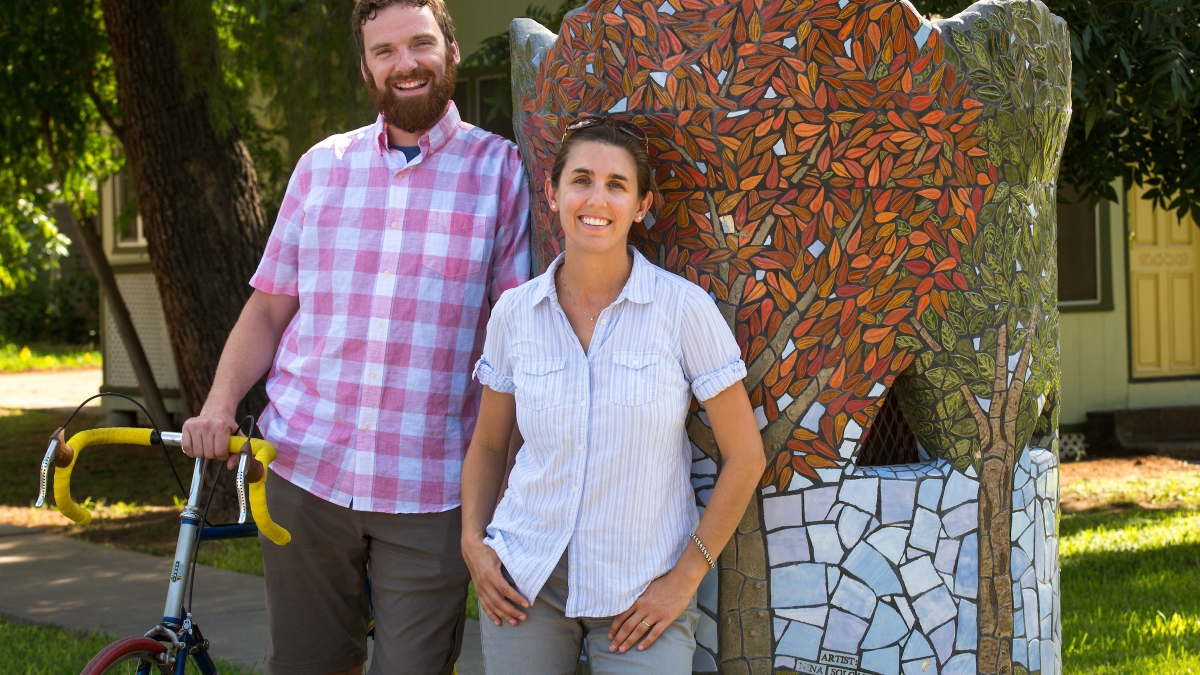Eating your vegetables can make you healthy. Growing them can make you happy.
That's one of the things Arizona State University assistant professors Deirdre Pfeiffer and Scott Cloutier found as they researched the secrets to planning a happy neighborhood.
The interdisciplinary pairDeirdre Pfeiffer is an assistant professor in the School of Geographical Sciences and Urban Planning, an academic unit of the College of Liberal Arts and Sciences. Scott Cloutier is an assistant professor in the School of Sustainability. outlined their findings in a paper recently published in the Journal of the American Planning Association, a top-ranked journal in urban development and urban studies, and have put them into action in the metro Phoenix area — including building raised garden beds for a widow who had lost her passion for gardening when she lost her husband.
In the paper, Cloutier and Pfeiffer (pictured above) identify three key planning-related factors that promote happiness: access to open and green space, environmental design that promotes social interaction, and places that are safe and secure.
“There’s a long history in urban planning of researching how to design a neighborhood to promote health,” said Pfeiffer but it usually focused on physical health, with planners prioritizing things like adding more sidewalk space to combat obesity.
Pfeiffer said she and Cloutier saw a real opportunity to take advantage of a space where other planners had been missing out: how the design of a neighborhood can promote mental health.
So together, they culled and analyzed an extensive amount of existing data from studies looking at the correlation between happiness and lifestyle factors. They ended up finding some consistent themes, which helped them to identify the three key planning-related factors.
The first factor, access to open and green space, Pfeiffer says includes things like parks and places where people can recreate, as well as places of “wonder and self-exploration,” such as an open field.
“There are so many tangential benefits that come along with being in nature,” added Cloutier. “It gives people space to disconnect form everyday life and connect with community and their inner self.”
The second factor, environmental design that promotes social interaction, refers to things like houses with front porches or shared lawns; features that enable people to happen upon each other and engage in social interaction.
The third factor, safety and security, refers to things like adequate lighting and safely designed crosswalks.
In their research, Pfeiffer and Cloutier also suggest strategies planning professionals can use to measure all three “happiness” factors, and evaluate the extent to which proposed plans, policies and projects would lead to better health outcomes.
In particular, they describe a tool that they’ve developed and used, the “Sustainability through Happiness Framework.” The tool complements health impact assessments – a more widely-used planning tool – by allowing planners to engage with neighborhood residents, and collaborate with them to better understand and implement changes that will create happy places to live.
It could be “something as simple as putting in a stop sign,” said Cloutier, who each semester brings together ASU students, local non-profits, organizations and government entities to help improve local communities.
Using the Sustainability through Happiness Framework has led to improvements that include canal beautification, safety and education programs, improved lighting, introducing solar power and carving out social spaces for residents.
“Everyone's happy, content to consume homegrown produce, backyards are clean, hazardous garbage is properly disposed of, and there is peace and order,” one Valley resident said of the positive changes in her Tempe neighborhood.
Pfeiffer and Cloutier are optimistic about the effect their study may have on future inquiry.
“It’s just such a rich territory for further research,” said Pfeiffer. “One of our hopes is that by publishing this study, we’ll influence other researchers” to look further into the area.
Top photo by Charlie Leight/ASU Now
More Health and medicine

Dynamic data duo advances health research
The latest health research promises futuristic treatments, from cancer vaccines to bioengineered organs for transplants to medical nanobots. While these technologies may one day be…

New study reveals high levels of toxins in seized cannabis from Arizona and California
A recent study conducted by researchers from Arizona State University has uncovered alarming levels of Fusarium mycotoxins in illicit cannabis samples seized in Arizona and California.The study found…

PhD student builds bridges with construction industry to prevent heat-related illnesses
It is no secret that Arizona State University has innovative researchers working to help solve everyday problems.According to a new preliminary report issued by Maricopa County, there were more…


